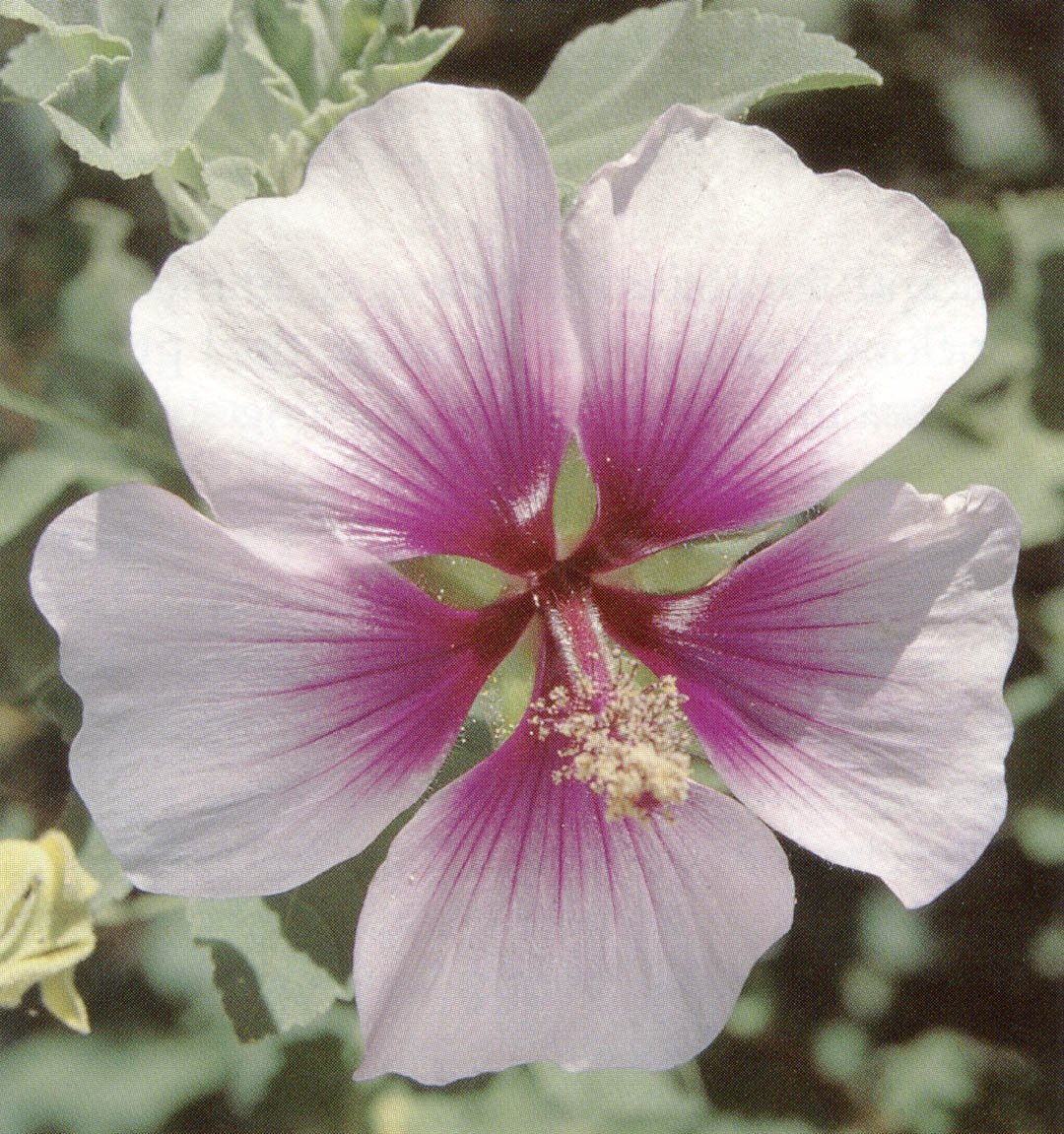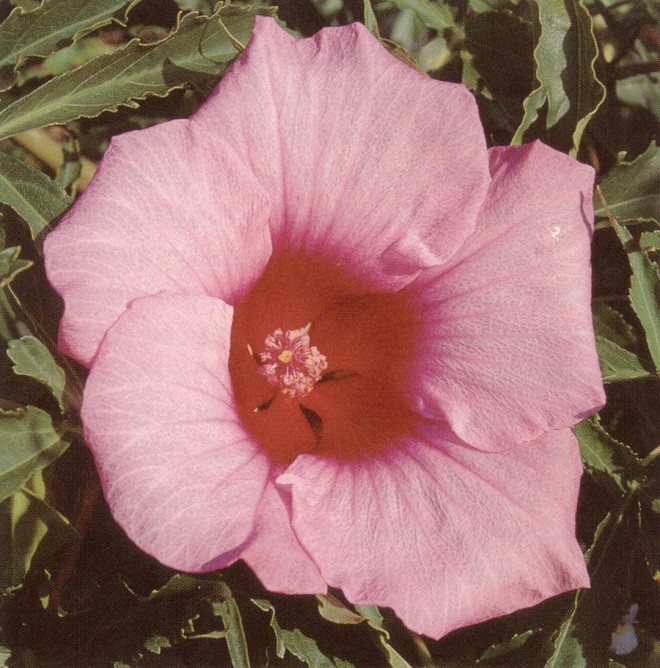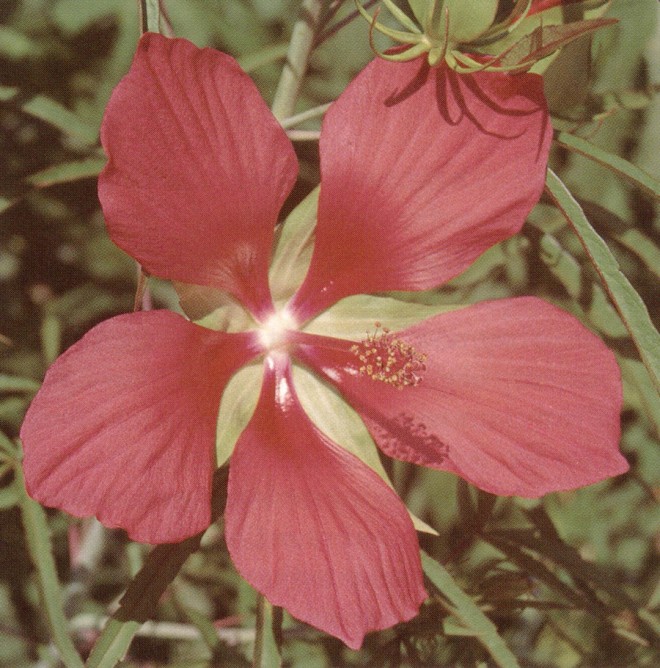

Contributor
- Topics: Archive, Plants You Need
Mallows share the five petals of Geranium flowers, but differ in the large number of stamens which are often fused into a tube around the style. The Malvaceae family is large and its members, which include many woody species, are most abundant in the tropics.
Dr John Grimshaw, The Gardener’s Atlas
With over one hundred genera and nearly 2000 species, the mallow family (Malvaceae) includes a fascinating and beautiful array of plants found in both tropic and temperate regions and on all of the continents. They range from trees such as Australia’s cow-itch tree (Lagunaria patersonia), to Asia’s shrubby rose-of-Sharon (Hibiscus syriacus), to perennials such as the North America’s rose mallow (Hibiscus moscheutos), Mediterranean annuals (H. trimestris), and even a few plants usually classed as weeds, such as common mallow—California’s cheese weed—(Malva parviflora).
The typical mallow flower has been described as having the most perfect form. Five separate petals form a round, bowl-like shape. Numerous stamens cluster in a tube around the pistils, which are often an important part of the flower’s architecture, extending well beyond the petals. In many cases the pistils are a contrasting color, often elaborately branched or segmented, and are key distinguishing characters defining members of this large family. Flowers generally stay open only one day, whether they are on the plant or cut for decoration. Hibiscus are worn as ornaments in the hair of Polynesian girls, and the Victorians called the flower of abutilon the “poor man’s boutonniere.” Mallows rival the rose in every way except for fragrance; with few exceptions, members of this family are scentless.
Mallow leaves are usually palmately lobed, resembling maple leaves. For this reason the abutilons are commonly called flowering maples. Frequently, the leaves are finely cut as in the desert species of Sphaeralcea spp., Hibiscus coccineus, rose-of-Sharon, and recent hybrids of tropical hibiscus (H. rosa-sinensis).
Mallows have many uses besides adding ornament to our gardens. Cotton (Gossypium hirsutum) is the best known, providing us with the soft absorbent fibers used in clothing and linens. Okra (Abelmoschus esculentus) is a key ingredient of many cuisines. The roots of the European marsh mallow (Althaea officinalis) are the source of the distinctive texture in the marshmallows we enjoy over campfires.
Mallow flowers come in a wide range of colors: deep blues of Australia’s Alyogyne huegelii, reds found in many genera around the world, yellows found mostly in species from the tropics, and in hollyhocks (Alcea spp.)—and virtually all color combinations in between. Many are easily cultivated, hybridize readily, and are widely used in ornamental horticulture for their strong foliage and showy flowers.
Soil and climate preferences vary widely among the genera. In moist tropic soils grow hibiscus and Hawaiian lei flower (Sida fallax), and in temperate wetlands of North America, Hibiscus coccineus. Desert regions boast several species of Sphaeralcea, Hibiscus denudata and H. cardiophyllus, and Arizona wild cotton (Gossypium thurberi).
I fell in love with the mallow family with my first abutilon (found in a Cleveland florist shop) and have grown a great number of them in gardens in New Jersey and, for the past twelve years, in Danville, California (Sunset zone 14, USDA zone 9). I’ve learned that temperature plays a major role in the flowering season of mallows. The majority need heat to flower well, filling our summer garden with floral drama; some, however, flower best with the cooler temperatures of spring and fall in this part of interior California.
It’s Okay to be Cool
Two species of Lavatera survive our hot summers, even without water, but will cease to flower vigorously when temperatures remain above 80°F. Tree lavatera (L. thuringiaca), from central and southeastern Europe, sits dormant during the cold winter (temperatures in the 20s and 30s °F), but, as soon as temperatures begin to rise, it can grow three to four feet in a month. By May, it has begun to put forth a mad display of mostly pink flowers. In cooler coastal gardens, it seems to have a prolonged display of flowers, in fact nearly year-round. This species is not long lived, rarely lasting more than five years. It grows well, with or without summer water. Summer irrigation will prolong the flowering in hot summer areas, but too much water can also result in stem and root rots, killing the plant seemingly overnight.

Originating in the western Mediterranean, Lavatera maritima (syn. L. bicolor), will often flower through winter when temperatures drop into the mid-20s °F, but it does not survive temperatures below 10°F. It will grow with or without irrigation in California gardens. Often described as a four-foot tall shrub, in my experience (with summer water) this species reaches well over eight feet tall. It flowers nearly all year, but its heaviest period is in spring and fall. The extreme temperatures of summer and winter in our area slow it down.
Lavatera trimestris, a Mediterranean annual, prefers to germinate in late summer or early fall. It develops all winter into a bushy mound three feet by three feet, and flowers prolifically until the summer heat causes it to shrivel and die. The several species of Malope from Spain and North Africa follow a similar growth cycle.

Flowering maples (Abutilon spp.) respond to cool weather with profuse flowering. This genus is found on most continents, but the garden hybrids available today stem primarily from Brazil and elsewhere in Latin America. After a tremendous spring flush of growth and flowering, they blossom sparsely for me in the heat of summer; as temperatures cool down in autumn, they offer a second flowering that continues as temperatures reach the mid-20s°F in winter. More prolific flowering can be encouraged by giving them more water in summer.
Trailing abutilon (Abutilon megapotamicum) will flower through winter, withstanding many frosts and even after losing most of its leaves when temperatures dip briefly into the high teens. The winters of 1990 and 1998 knocked these abutilons to the ground when temperatures reached 8°F and 15°F respectively, but for the most part this species is root hardy; my plants resprouted from their bases.
Unfortunately, abutilons are plagued by white flies in some parts of the Bay Area. In one garden in nearby Diablo, we decided to let the plants grow without any coddling. The plants have grown into fine specimens and, over the years, the whitefly infestation has abated somewhat.
Anisodontea capensis, a South African native, also performs better in the cooler temperatures that prevail from fall through spring here in Danville. My favorite cultivar, ‘Tara’s Choice’, will flower through an entire winter of nighttime temperatures in the mid-20s°F. Although it flowers sporadically in summer, the flowers tend to be smaller and faded compared to those produced in the cool season. Though not long lived, once established it will survive without summer water. With summer irrigation, it grows into a substantial bush, nearly five feet tall.
Australia’s blue hibiscus (Alyogyne huegelii) is another cool weather performer. As temperatures rise in summer, plants get seedy; dead-heading stimulates flower production, as does more summer water. It is unfortunately not as hardy as the previous species, but it is root hardy to 8°F, as proven in the big freeze of 1990. Though it gets knocked down in some winters, the intense lavender-blue of the flowers makes it well worth growing.

The globe mallows (Sphaeralcea spp.) of our Southwestern deserts are beginning to appear in nurseries. The biggest challenge to their successful cultivation outside the desert is the especially wet winters that most gardens enjoy elsewhere on the West Coast. Sphaeralcea fendleri has proven successful in my garden, surviving forty-five inches of rain in the El Niño winter of 1997-98. This pink-flowering, slowly running, shrubby perennial graciously re-seeds around my garden. It survives both with and without summer watering, actually performing better with some summer water. In spring it puts forth masses of hollyhock-like stems covered in inch-and-a-half, globular, mallow blossoms. As the plants become seedy, I cut them back and give them an extra drink or two, causing them to produce a flush of new foliage and flowers. This species begins flowering as early as April and continues well into November. During the unusually cool summer of 1999, plants flowered for the entire season with no extra work, leading me to conclude that they would be good candidates for cooler gardens near the coast.
I traveled to Tucson, Arizona, in the autumn of 1999, curious to see the impact of the longest monsoon season on record. There were virtually no globe mallows in flower, even after such exceptional rains. Perhaps cool nighttime temperatures, which Tucson does not experience in summer, may be the trigger that bring on flowering. In the desert, globe mallows generally start flowering in February.
Another excellent globe mallow, Sphaeralcea incanum, also seems to love the cool weather of spring, producing soft orange flower spikes that can reach five feet tall. Other species of Sphaeralcea offer blossoms in colors ranging from white through pink and red to orange.
When You’re Hot, You’re Hot!
The heat of summer brings the showiest mallows into flower, particularly in the genus Hibiscus. Tropical, or Chinese, hibiscus (H. rosa-sinensis), is probably the best known of the mallow family. The red flower in the Polynesian girl’s hair is an image symbolizing beauty, relaxation, and paradise. It hybridizes exceedingly well, resulting in cultivars now regularly sporting blossoms eight inches or more across and offering luscious color combinations such as lemon, peach, deep pink, and, more recently, gray.
I keep these tropical shrubs in containers in my garden. They need plenty of heat to start flowering, usually beginning in late July. Although not usually recommended for full sun all day, they do well for me if their pots are standing in a saucer of water. Aphids are a problem, especially when ants, attracted to aphid secretions, become active in the heat and move into the pots. I usually treat this problem by immersing the pot in water for a day; then I spray the foliage with a soap-based insect repellant, or a solution of one part sudsy ammonia and seven parts water. Potted hibiscus need to be fertilized regularly with a good time-released fertilizer.

Some of the largest flowers in the family come from common rose mallow (Hibiscus moscheutos), a hard to find native American species whose flowers can be up to twelve inches across. Outrageous, you say? Garish? Perhaps, but in the hot summer areas of interior California, this heat-loving perennial maintains its color in the intense light of the midday sun. I have planted it among my roses, and, as the heat builds up and the roses lose their vigor, the rose mallow begins to open its attention-grabbing blossoms. In spite of its substantial growth and spectacular flowers, this species does not need heavy fertilization. I grew a number of hybrids of rose mallow in New Jersey and the plants became larger every year; winter dormancy probably plays an important role in the plant’s vigor. The Fleming brothers, plant breeders in Lincoln, Nebraska, have developed a cultivar called ‘Kopper King’ that produces copper-colored leaves and white ruffled flowers up to twelve inches wide. The foliage is a distinctive addition to any garden, even if the flowers are scarce—or overwhelming!
California has its own native species of hibiscus, Hibiscus lasiocarpus. which is also found east of the Mississippi. It grows along riverbanks and is rare due to the destruction of its habitat. A nice stand can be found in California native plant section at the University of California Botanical Garden in Berkeley. They flower in late summer with six-inch pink or white blossoms atop six-foot stems.
Rose-of-Sharon (Hibiscus syriacus) also flowers heavily during the hot weather of summer. This deciduous woody shrub has been extensively bred from its original colors of white, red-purple, and lavender-blue—usually with a maroon center. Readily available now are ‘Blue Bird’, a near-blue, ‘Diana’, a clear white, and ‘Helene’, pure white with reddish-purple eye. Common in gardens in Asia, Europe, and North America, rose-of-Sharon does extremely well in California’s frosty interior regions. They are relatively drought tolerant once established, although summer irrigation causes them to explode with color. They seem to perform nearly as well nearer the coast.

Hibiscus coccineus is a Texas swamp native whose palmately lobed, red-tinged, dark green leaves have serrate margins. The deep red flowers can be as much as four inches wide. This would make a dramatic addition to a bog or shallow water garden, yet it does relatively well in a garden bed with moderately moist soil in my garden.
Hollyhocks (Alcea rosea) begin to flower in early spring, continuing merrily all summer into fall. This they do in full sun without any additional irrigation, even in the hotter inland areas of California. Most colors but blue can be found in this species, along with a seductive black-flowered selection called ‘Nigra’ and a new yellow-flowering selection from Siberia that seems to outlive typical hollyhocks. Most live two or three years, but reseed generously, dropping seed while the stalk is still opening flowers. They will germinate during cool winter rains, although not as prolifically as they might if we had warm summer rains.
Many species of Pavonia demand heat before they will begin to flower. P. hastata is much-maligned because its flowers will not open without a great deal of heat; plants at the University of California Botanical Garden at Berkeley rarely open their flowers, but since each flower is self-pollinating, they still produce plenty of seed and spread like weeds without providing any color. In the warmer areas, it presents glorious sprays of white flowers with red throats well into October; it needs little water in my garden and provides me with plenty of seedlings to give to friends. It tends toward a prostrate habit that I particularly enjoy when cascading through grasses.

Abelmoschus is another heat-loving genus, mostly tropical in origin. Manihot (A. manihot, syn. Hibiscus manihot), from tropical Asia, forms a basal rosette of leaves from which rise flower stalks topped by beautiful, creamy-yellow three- to four-inch flowers with nearly black throats. Often mislabeled as A. manihot in nursery catalogs, A. moschatus is a low-growing tropical, whose flowers range from red to pink. It acts as an annual in our garden and would reseed readily during hot summer days if it were located in a well-watered location. Both species are treated as annuals although manihot is root hardy to the low 20s°F and to brief periods in the high teens; it survived the temperatures of the December, 1998 cold spell, when temperatures dropped into the mid-teens for five consecutive nights. Both are encouraged to flower only after prolonged periods with daytime temperatures above 80°F.
[sidebar]
Mallow Resource Guide
Sources of Mallow Plants & Seeds:
Logee’s Greenhouses
141 North Street
Danielson, CT, 06239
203/774-8038
Plant Delights Nursery
9241 Sauls Road
Raleigh, NC 27603
919/772-4794.
Plants of the Southwest
Route 6, Box 11A
Santa Fe, NM 87501
800/788-7333
Shady Oaks Nursery
1101 S State St, PO Box 708
Waseca, MN 56093
800/504-8006
California Horticultural Society
plant sale and seed exchange
415/566-5222
Huntington Botanical Gardens
annual plant sale
626/405-2141
Kristin can be contacted at yankerhans@aol.com
[/sidebar]
Mallows, unfortunately, are loved by deer and gophers. A few, such as Anisodontea capensis, and Alyogyne huegelii, are known to survive the deer, but not in every garden. Some of our native species such as Sphaeralcea fendleri have survived gophers in my garden. If, however, your garden is protected from such creatures and you have suitable conditions, mallows can be wonderful additions to the landscape. They supply strong, long-season color, interesting foliage, and, in many instances, excellent cut flowers. Many will grow with minimal irrigation even in interior California. They definitely belong in our West Coast gardens.
Share:
Social Media
Garden Futurist Podcast
Most Popular
Videos
Topics
Related Posts

Low Maintenance Gardens – Better for Pollinators and People
Autumn 2022 “I come out every day. It’s therapy, my meditation.” Janet’s young garden transformed from overgrown, invasive plants to mostly natives. The dailiness of

Calochortophilia: A Californian’s Love Affair with a Genus
Summer 2022 I can chart the progression of my life by Calochortus. For the last two decades, at least. As a teenage girl growing up

Pacific Plant People: Carol Bornstein
Spring 2022 Public gardens play a key role in demonstrating naturalistic planting design, selecting native and adapted plants for habitat, and testing techniques for reducing

Add Year-Round Interest and Winter Blooms for Pollinators
Spring 2022 This article was created from an Interview by Merrill Jensen with Neil Bell in the Summer of 2021 for our Pacific Plant People









Responses